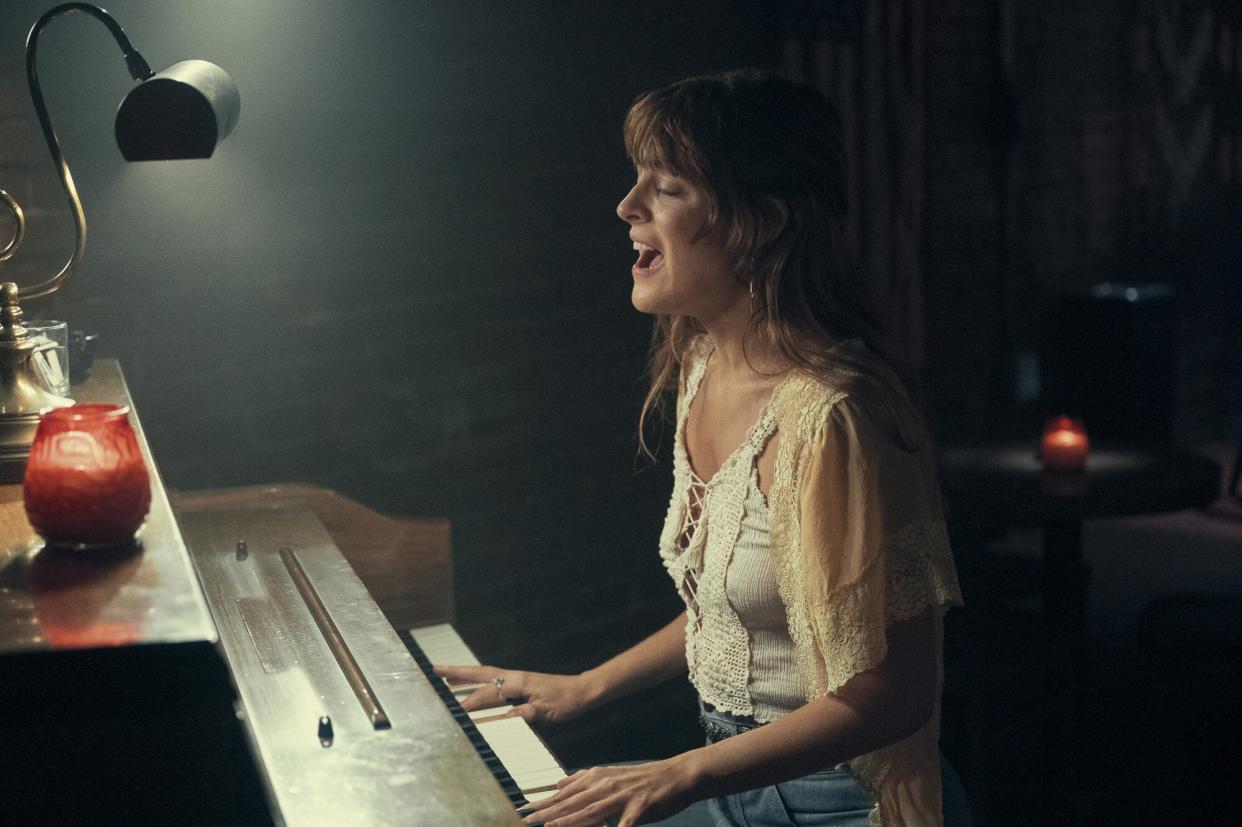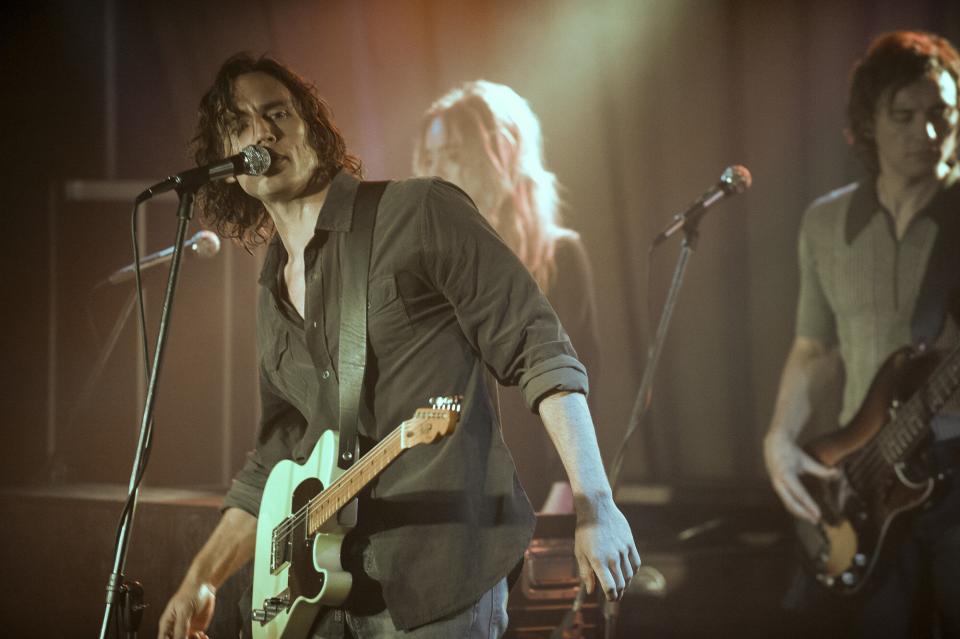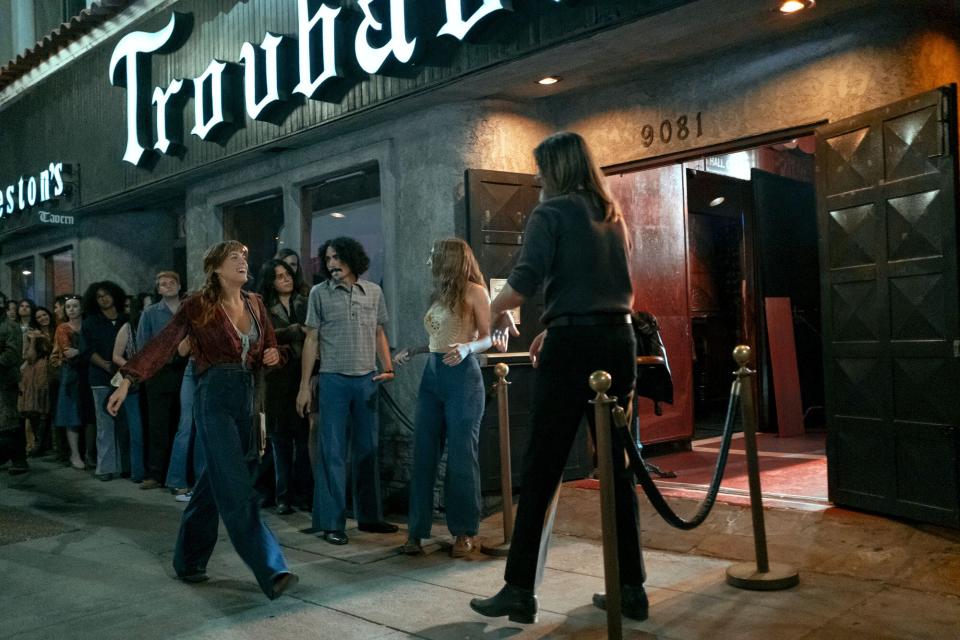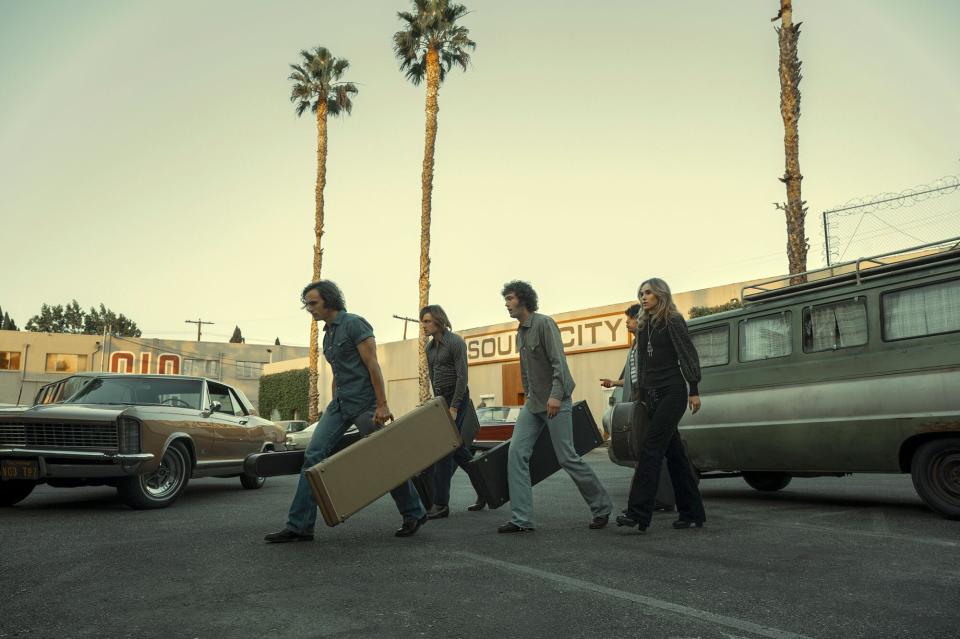A guide to the classic rock locations in Daisy Jones & the Six

- Oops!Something went wrong.Please try again later.
From Almost Famous to Rocketman, the 1970s rock scene in Los Angeles has become mythical in stature, at least when it comes to how it's portrayed in the movies.
Daisy Jones & the Six, which hit Prime Video on Friday, is the latest to pick up the Laurel Canyon mystique and its proximity to the Sunset Strip and the Hollywood Hills. The series, based on a Taylor Jenkins Reid novel of the same name, follows the titular (fictional) band from their rise in the early 1970s to their eventual implosion in 1977 — and through it all, it takes us on a tour of Los Angeles' most iconic rock hot spots.
But unlike many previous projects, Daisy Jones & the Six was able to actually film in several of these locations, bringing the history and the ghosts of the past to life on screen.
Scott Neustadter, who co-created the series with Michael H. Weber, sat down with EW on a recent sunny Friday afternoon on the roof of the Riot House — now the Andaz West Hollywood — a location that makes an appearance multiple times in the series.
Just a few feet away from a pool that Jimi Hendrix reportedly once jumped into, we sipped iced tea as Neustadter, a lifelong rock junkie, touted the work of production designer Jessica Kender and walked us through the locations that allowed him to go behind the velvet rope.
The Sunset Strip
In the late '60s and early '70s, the Sunset Strip was the place to be if you were an aspiring musician or rock music fan. From the Whisky-A-Go-Go, which boasted the Doors as their house band for a time, to the iconic Tower Records, there was no shortage of jams and nightlife. But in the years since its peak, the Strip has transformed into less of a musical destination and more of a tourist and shopping locale. For Daisy Jones & the Six, they needed to recreate it as it once was.
"All of the conversations that we had were, 'How are we going to pull this off?'" Neustadter says. "Because yes, you can go and shoot on the Strip, but it doesn't look like it used to look. There were a lot of conversations about soundstages or finding a street in the Valley that sort of looks like the Strip, which we could transform much easier than you could do this."
"But our team was like, 'Just give us a block and we will take it down and we will make it look like it used to look,'" he marvels. "Then the DP and the lighting people had to figure out how to shoot it, like, 'We have to shoot this way because that billboard's not going to work.' All of that technical stuff was amazing."
Production ended up taking over and shutting down a portion of the Strip for a week, while they returned it to its former glory. It makes plenty of appearances in the early storytelling, from the groupie days of Daisy Jones (Riley Keough) at the Whisky to the Six's first drive into Los Angeles.

Lacey Terrell/Prime Video Riley Keough as Daisy Jones
The Whisky
Of all the places on the Strip, the Whisky is perhaps the most iconic — and they really shot in the actual space.
"We shut down the Whisky on my birthday," Neustadter tells EW with glee. "It looks very similar [to how it did then], but you have to take out all of the equipment that would've been too modern, which is a lot of things. The room where Daisy comes in and plays the piano at the end of the first episode, it was upstairs at the Whisky. We're pretending like it was a different place, but that's in that space also."

Lacey Terrell/Prime Video Sam Claflin as Billy Dunne
Filthy McNasty's
Desperate for a break, the Six book a steady gig at Filthy McNasty's courtesy of a phone call from Rod Reyes (Timothy Olyphant). The legendary bar, which once hosted the likes of Mick Jagger and Elvis Presley (coincidentally, also Keough's grandfather), is now the Viper Room.
"We had to take that back down to the studs to make it look like it used to look," says Neustadter. "We did all that stuff in the actual space. Almost all of the places in the show that we're saying we're at, we actually are at, which I'm really proud of."
The Troubadour
While the Whisky was the scene for harder rock, the softer sounds of folk rock, as established by artists such as Carole King, The Eagles, James Taylor, and Linda Ronstadt, made their home at Doug Weston's the Troubadour. It also marked the location for Elton John's first U.S. show. For Neustadter, it's always been a sacred space. And it is home to plenty of concerts on the series.
"When I first moved here, I feel like I lived there," he says. "I was there like four times a week. It's where all the bands I liked played. So, I'd been there a million times and taking that over was such a dream. We shot where the bands hang out, the equivalent of backstage, which is up the stairs. I'd never been in any of those rooms. Being there and being able to walk into the bowels of it and see areas of it that I was never allowed to see before — it was really fun."

Lacey Terrell/Prime Video Riley Keough as Daisy Jones arriving at the Troubador
It was also the easiest space to use in terms of period accuracy. "That looks like it used to look," adds Neustadter. "It's pretty well maintained. A lot of the stuff we had to do there was lighting stuff. But the space itself, not much work had to be done there."
Riot House
The Continental Hyatt House hotel on the Sunset Strip, lovingly dubbed the Riot House, was a major destination for rock stars in the 1970s. With its proximity to music clubs, the likes of Led Zeppelin, the Rolling Stones, and the Who stayed at the hotel while in Los Angeles.
The rooftop pool is a major location in Daisy Jones & the Six. We see it in the first episode, as a teenage Daisy reckons with a sexual assault amidst a crowd. It also reappears in later episodes, serving as a key spot in one of the story's numerous romantic complications. It required some minor redressing to match the pool chairs and layout of the 1960s and '70s.
"When Daisy is with the man who's too old, young Daisy's sitting there in the corner and he's not paying attention to her, that's here," Neustadter says, gesturing to the pool area. "Which is why she never comes back here. We had the same location manager who worked on Almost Famous. He said there was a big scene in Almost Famous that they wanted to be up here, but that they ended up not being able to do it up here. They did it in the lobby for some reason. We were able to come up here and shoot, and that was pretty cool."
One thing you won't see on screen? Neustadter recreating a famous moment in rock history that also inspired a scene in Almost Famous. "There's a really famous photograph of Robert Plant [of Led Zeppelin] on the balcony doing his Golden God thing, which is here," he says. "We had the room when we were shooting here, so I tried to replicate the picture." (Fans of Almost Famous will recognize Billy Crudup's iconic piece of dialogue that references the same photograph).
Sound City
When it comes to recording studios, besides London's Abbey Road, there's few that are as famous or momentous in rock history as Sound City. It's where Mick Fleetwood discovered Lindsey Buckingham and Stevie Nicks (and Fleetwood Mac went on to record there, including Rumours track "Never Going Back Again"), and where Tom Petty and the Heartbreakers recorded all of their early hit-making albums. Not to mention sessions with Neil Young, Elton John, Bob Dylan, Nirvana, and more. Their analog equipment captured some of the world's most beloved music.
Now, it's also where Daisy Jones & the Six created their multi-platinum album Aurora. "Sound City is a place I never would've thought I'd find myself at," marvels Neustadter. "Now, I know my way around there. We took it over for a month and shot all of the recording scenes, including all of episodes 5 and 6 there."
"Where Buckingham Nicks was recorded is where the Dunne Brothers start recording," he explains. "And before Daisy joins the band, the scene where Daisy records 'Look At Us Now,' that's in Studio A, where Buckingham Nicks was recorded."

Lacey Terrell/Prime Video Sam Claflin as Billy, Josh Whitehouse as Eddie, Will Harrison as Graham, Sebastian Chacon as Warren, Suki Waterhouse as Karen
In short, they are telling a story of fictional rock history in the space where it was actually made. "This is the space where Mick first heard Lindsey; it's the coolest thing in the world," Neustadter says. "Shooting it in those spaces, you feel the ghosts of those who were before you and everybody played off of it in a really nice way. [The cast] got something extra, something spiritual going on that made everybody so appreciate that we weren't at a Paramount soundstage."
However, with changes in instrumentation and technology, Sound City has changed significantly since the 1970s, even lacking the painted signage outside the studio that looms in the background of numerous shots. "Sound City was the biggest re-dress we had," he adds. "It looks nothing like it did. But they would take a lot of pictures back then. [Our team] saw some footage, and they recreated it the way it used to be — put up walls and such, it was almost unrecognizable."
The owners of Sound City liked some of the historical redos so much, they asked the Daisy Jones crew to leave them in place. "They kept it as-is a little bit, especially the outside facade," Neustadter says. "They were like, 'Don't take that down. You want to retain that.'"
Eateries
Throughout the series, the characters eat at various Los Angeles restaurants and hot spots. Two of the most famous, which play themselves on the show, are the Apple Pan and the Formosa Cafe.
Laurel Canyon
As home to many singer-songwriters in the '60s and '70s, Laurel Canyon has taken on a near-mythic status. So, of course, it's where these characters would choose to live. But when it came to residences, that's where the show had to do a little fudging.
Daisy Jones lives in the Chateau Marmont, but the production team designed to avoid the headaches that come with filming at one of the most iconic Hollywood destinations on the Sunset Strip.
Additionally, record producer Teddy (Tom Wright) and the Six needed Canyon homes that simply do not exist as they once did. "Teddy's house is up in Baldwin Hills, which is a great location," Neustadter details. "We didn't actually shoot Laurel Canyon for Laurel Canyon because it looks very different now. But one of the other canyons in Los Feliz and over there, we could manipulate a little bit better. We found this amazing house, and that's the Billy-Camila house where they have a party [in episode 4], and that was an amazing find."
Daisy Jones & the Six episodes 1-3 are streaming now on Prime Video. New episodes drop Fridays.
Sign up for Entertainment Weekly's free daily newsletter to get breaking TV news, exclusive first looks, recaps, reviews, interviews with your favorite stars, and more.
Related content:

